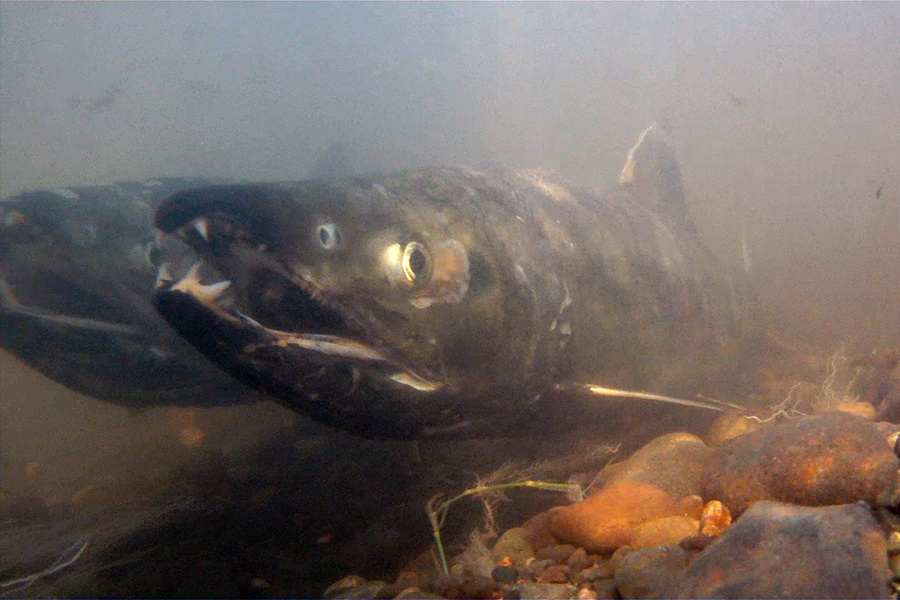Two chum salmon show the distinctive stripes that emerge after they enter freshwater to spawn. When the Northern Bering Sea, Chukchi Sea and Beaufort Sea warm together, conditions are right for Pacific salmon to swim all the way to the Western Canadian Arctic, research shows. (Photo provided by NOAA)
As the climate warms, more Pacific salmon from Alaska are showing up in the Western Arctic waters of Canada.
But residents in those Arctic Canadian communities are not catching salmon every year, which led them to ask why.
Now a study by scientists from Canada and Alaska has described the ocean gateway that must open to bring salmon from the Bering Sea to those far-north sites.
Conditions must line up over vast stretches of ocean for salmon to make the journey through the Bering Strait, across the Chukchi Sea and into the Canadian Beaufort Sea and the freshwater bodies upstream from it, the scientists found.
“What appears to need to happen is you need a warm late springtime Chukchi sea,” said Joe Langan of the University of Alaska Fairbanks, one of the lead authors of the study, published in the journal Global Change Biology. Those conditions probably correlate with a warm Northern Bering Sea, he said, adding that beyond the Chukchi, a warm coastal Beaufort Sea is also necessary.
In the past, those different seas have often followed different patterns, with some cold while the others are warm. As sea ice melts earlier, water temperatures rise and ice forms up later, the seas’ warm conditions are more likely to converge, Langan said, allowing the ocean gateway for salmon movement north to be open more consistently.
For now, the appearance of Pacific salmon in Canadian Arctic waters is hard to predict, even mere months in advance, he said. “It’s going to be volatile in the near term,” he said.
Recent years are examples of that volatility.
In 2019, a record-warm year in which ocean waters off Alaska were uniformly warm, there were abundant Pacific salmon swimming into the Canadian Arctic and harvests were high, Langan said. Three years later, when waters had turned cold, no Pacific salmon were caught in those Canadian Arctic communities, he said. Passage through the Bering Strait, Chukchi Sea and Beaufort Sea are just part of what it takes for salmon populations to become established in waters that far north, said Karen Dunmall of Fisheries and Oceans Canada, another lead author.
Frankie Dillon holds a chum salmon caught in 2023 near Aklavik in Canada’s Northwest Territories. (Photo by Colin Gallagher/Fisheries and Oceans Canada)
An earlier study she led, published in 2022, described the first documented discovery of a juvenile chum salmon in waters flowing into the Beaufort Sea – proof that, at least in that year, Pacific chum salmon had successfully reproduced in their new Arctic territory. That young chum salmon was found in 2017 in Jago Lagoon, near the Inupiat village of Kaktovik and near the Alaska-Canada border on the Arctic coastline.
Since then, there have been related discoveries. Last year, a UAF research team found about 100 chum salmon that were spawning in tributaries of the Colville River, a major river on Alaska’s North Slope that flows into the Beaufort Sea. While spawning is not necessarily followed by successful reproduction, that was another significant discovery about the northward spread of Pacific salmon.
Although they are harvesting this Pacific salmon when it appears, residents of Canadian Arctic communities, some of them contributors to the new study, have some concerns about the new arrival in these waters, Dunmall said.
People who have depended on more Arctic species have questions about possible disruptions, she said. “Will the salmon take over the rivers? What’s going to happen to the char? Do they spawn in the same places? Are they eating the same things?”
Even along the Mackenzie River and similar spots, where salmon harvesting is a tradition, the appearance of different salmon can be unsettling. “There is still concern about salmon, but more from a perspective of that they’re an example of a changing climate, a changing Arctic,” Dunmall said.
She and her colleagues are continuing to investigate the impacts of salmon emerging that far north.
One focus is the interaction with Dolly Varden, a species that, like salmon, spawns in freshwater and migrates to saltwater. While the Arctic is warming fast, it is still cold in the winter, and while the discovery of that sole juvenile chum salmon shows that reproduction that far north is possible, a lot of hurdles must be overcome for that to happen, Dunmall said.
“Salmon come in and spawn in the fall. The eggs incubate. They have to do that at a suitable temperature so that they can emerge at the right time where there is food available and then access to the ocean or other habitats,” she said.
Other ongoing research is examining the food that salmon are eating in their new territory and whether there is enough for all the species. She and her colleagues are also investigating whether the newly arriving salmon might be bringing disease pathogens to the Arctic territory.
On the west side of the Bering Sea, pollock and Pacific cod are making their way up through the Bering Strait and across the Bering Sea into the East Siberian Sea, a newly published Russian study says.
Pollock and Pacific cod are among six species that are on the move north, either from the Pacific side or from the Atlantic side, into Siberian waters that now have less ice as the climate has warmed, said the study, published in the journal Progress in Oceanography. Other species with movements described in the study are northern wolffish, beaked redfish, Greenland halibut and glacier lanternfish.
SUPPORT NEWS YOU TRUST.
The post Pacific salmon move north to Arctic Canada from Alaska when ocean conditions allow appeared first on Alaska Beacon.

